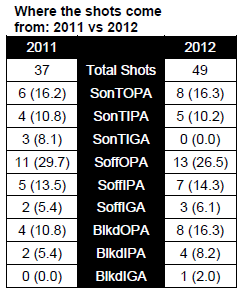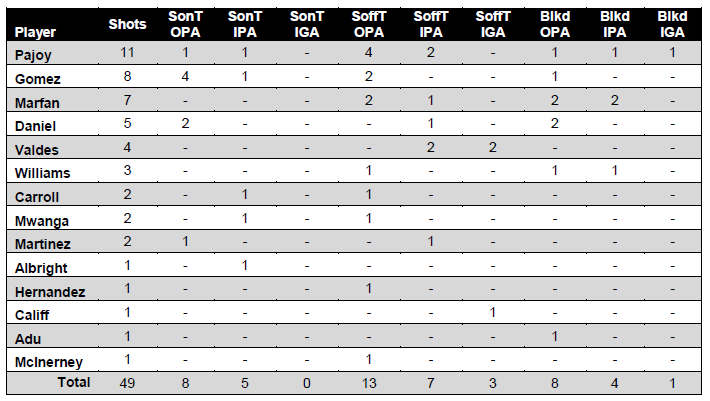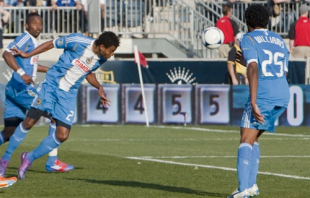Photo: Daniel Gajdamowicz
In 2011, the Philadelphia Union played 9 games before they conceded as many goals as they did in the first 3 games of 2012. Coming off the heels of two shutouts and the Union defense seemingly settling into the kind of form we’ve all come to expect after 2011, attention has sharpened on the Union offense.
The main subject of attention is of course the lack of goals. In 2012, the Union have 3 goals after 5 games, 1 from a free kick taken from outside the penalty area, and 2 from inside the penalty area. Of those two from inside the penalty area, 1 was a header that followed a corner kick, the other from a penalty kick.
 Looking back to 2011, the Union had only one more goal after 5 games than they do now. Of the 4 goals over the same period of time, 2 came from shots inside the goal area, 1 from inside the penalty area, and one from a free kick taken from outside the penalty area. The problem is obviously that the Union conceded only 2 goals over the first 5 games in 2011 compared to the 6 conceded in 2012, a problem that is underscored when you consider that the Union’s opposition has produced exactly the same number of shots in 2012 as in 2011.
Looking back to 2011, the Union had only one more goal after 5 games than they do now. Of the 4 goals over the same period of time, 2 came from shots inside the goal area, 1 from inside the penalty area, and one from a free kick taken from outside the penalty area. The problem is obviously that the Union conceded only 2 goals over the first 5 games in 2011 compared to the 6 conceded in 2012, a problem that is underscored when you consider that the Union’s opposition has produced exactly the same number of shots in 2012 as in 2011.
Are the shots coming?
The difference is that the Union’s opponents have so far been more accurate with their shots. In 2011 opponents produced 11 shots on target and 29 off target with 19 shots that were blocked. In 2012, the opposition has so far produced 17 shots on target and 23 shots off target. With the number of blocked shots remaining the same, the gain of 6 shots on target is quite significant. While opponents’ goals from shots on goal percentage in 2011 was 18 percent, in 2012 it has nearly doubled to 35 percent.
While the opposition’s number of shots overall has remained the same, it may surprise you to learn that the Union’s shot total over the first 5 games has increased from 37 in 2011 to 49 in 2012. The problem is that the number of shots on target has remained the same at 13. The 12 shot gain comes from 5 more shots off target and 7 more blocked shots. With the number of shots on target remaining the same but the number of goals decreased, that means the Union’s goals from shots on target percentage has dropped from 31 percent in 2011 to 23 percent in 2012.
Of course, not all shots on target are the same, just as not all shots off target are the same. For example, the Union has twice hit the crossbar: Michael Farfan’s delicate effort just minutes after Lionard Pajoy had scored to bring the Union within a goal of equalizing with Colorado, and Carlos Valdes’ left footed effort against Vancouver. A couple of inches and the Union are 2–2–1 and in fifth place in the East.

Where the shots come from
If we look at where the Union shots have come from on the field an interesting point can be made. Shots are broadly categorized as coming from outside the penalty area or 18 yard box (OPA), inside the penalty area (IPA), or inside the goal area or six yard box (IGA). While the Union’s number of shots on target over the first 5 games has remained the same in 2012 as it was in 2011, the number of shots on target that came from inside the goal area has decreased by 3 while the number of shots taken from outside the goal area has increased by 2. This is noteworthy if we agree that shots taken closer to goal probably have a better chance of finding the back of the net than those taken from a greater distance. (Individual stats for where the Union’s shots are coming from can be found in the chart below.)
You don’t need to look at the greater number of opposition shots to think the Union should be taking more shots. And while it may be easy to look negatively at the big increase in both the number of shots off target and blocked shots, I prefer to look at the increases more positively. You don’t get goals if you don’t take your shots and the Union are taking more shots. Still, the increase begs this question: Is the Union creating as many quality scoring chances as they could?
Opportunities
When the Union coaching staff and players talk about being more opportunistic, they aren’t just talking about the need to take more shots (although Peter Nowak has made clear in press conferences that he wants the players to take more), they’re also talking about making those passes that lead to better shooting opportunities, about creating more favorable situations that result in greater chances of scoring. With the exception of the first half against Colorado, it is plain enough to anyone who has been watching the team that such circumstances are not abundant enough.
Opta categorizes such opportunities as a key pass, which is a pass that leads to a shot on or off target. Despite scoring more goals than their opponents, the Union’s 18 key passes over the first 5 games of 2011 was actually fewer than the opposition’s 33. That 15 key pass deficit was probably somewhat nullified by the Union defense blocking or forcing a higher number of shots off target in that season. In 2012, the Union’s opponents’ number of key passes has actually dropped to 29, but the total is still greater than the Union’s increase to 22.
So, better passing creates more key passes which should lead to better scoring chances which itself should lead to more goals. Here’s hoping the Union defense can maintain its form while the offense finds its way.



Im not that surprised. People want to forget just how bad our offense was last year, especially the first half, when whining about Le Toux.
Le toux or not, our offense has faced the same problems and issues for our whole history so far.
Pajoy: 11 shots/ 1 on target…Next!
You can worry about the SOG% of a single striker at a small sample size (or maybe you can wonder why this particular striker is getting all the minutes in place of others) but I’ll still focus on the historic inability of our entire midfield to link up and provide consistent quality service to our forwards.
There are numerous explanations and excuses but for our entire history we go into the next game not knowing whether to expect a flowing, coherent midfield possession game or a sloppy, inefficient long ball punt-a-thon.
I WISH the discussion on our offensive woes was simple enough that we could start and stop at “Pajoys sog% sucks LOLOLZ”
The midfield was quite serviceable against Columbus. Pajoy has been exposed as an innefficient striker. The previous midfield support had been awful, but that was not the case last weekend. He lacks the killer mentality. We need a striker that is going to try to get a piece of any ball that comes near him. Pajoy is not the guy. Time to try another option up top.
We need to get em near an eight ball
Ha Ha. It worked for Maradona.
Our offense wasnt bad last year. We scored 44 goals during the 2011 regular season (LA scored 48)…averaging 1.29 goals per game.
disregard the toronto game because that caused major stat inflation
Every team played Toronto last year…why would I disregard that stat?
Every team has “inflated your stats” games though, so you cannot penalize the U for blowing out Toronto last year…I hope we are as fortunate this year v TFC.
My philosophy is this, if we can beat the bad teams, get decent results (win and/or ties) against the middle road teams and lose to most of the good teams we will be in the hunt for the playoffs.
And per the “linking” play conversation that everyone is always so worried about. The only game in my mind where we were totally lost was the first one. Since then we have played good enough to win against: Colo, Fire and the Caps (and did against Crew).
In each game there were more then enough chances to score goals, so while the “linking” play has not been perfect, it is the finishing and chance creation in the box that have plagued us more.
The MLS is not the most fluid league we can all agree, the Union are doing a fine job in the mid-field (save the Portland game again)….it is banging the ball in the net that is our issue.